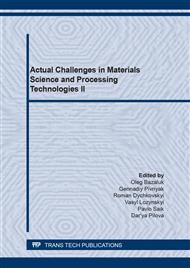[1]
Liu, S., He, Z., Zheng, L., Liu, B., Zhang, F., Dong, L., Zeng, Y. (2014). The thermal stability study and improvement of 4H-SiC ohmic contact. Applied Physics Letters, 105(12), 122106. https://doi.org/10.1063/1.4896320.
DOI: 10.1063/1.4896320
Google Scholar
[2]
Han, S.Y., Kim, K.H., Kim, J.K., Jang, H.W., Lee, K.H., Kim, N.K., & Lee, J.L. (2001). Ohmic contact formation mechanism of Ni on n-type 4H–SiC. Applied Physics Letters, 79(12), 1816-1818.
DOI: 10.1063/1.1404998
Google Scholar
[3]
Zhang, X., Tang, Y., Shen, H., Bai, Y., Huo, R., Wang, W., & Liu, S. (2014). Study on simultaneous formation of ohmic contacts on p- and n- type 4H-SiC using Ni/Ti/Al ternary system. IEEE International Conference on Solid-State and Integrated Circuit Technology. https://doi.org/10.1109/icsict.2014.7021382.
DOI: 10.1109/icsict.2014.7021382
Google Scholar
[4]
Tsukimoto, S., Sakai, T., Onishi, T., Ito, K., & Murakami, M. (2005). Simultaneous formation of p- and n-type ohmic contacts to 4H-SiC using the ternary Ni/Ti/Al system. Journal of Electronic Materials, 34(10), 1310-1312. https://doi.org/10.1007/s11664-005-0255-6.
DOI: 10.1007/s11664-005-0255-6
Google Scholar
[5]
Ito, K., Onishi, T., Takeda, H., Kohama, K., Tsukimoto, S., Konno, M., & Murakami, M. (2008). Simultaneous Formation of Ni/Al Ohmic Contacts to Both n- and p-Type 4H-SiC. Journal of Electronic Materials, 37(11), 1674-1680. https://doi.org/10.1007/s11664-008-0525-1.
DOI: 10.1007/s11664-008-0525-1
Google Scholar
[6]
Rogowski, J., & Kubiak, A. (2015). Effects of annealing temperature on the structure and electrical properties of tungsten contacts to n-type silicon carbide. Materials Science and Engineering: B, 191, 57-65. https://doi.org/10.1016/j.mseb.2014.10.015.
DOI: 10.1016/j.mseb.2014.10.015
Google Scholar
[7]
Yu, H., Zhang, X., Shen, H., Tang, Y., Bai, Y., Wu, Y., & Liu, X. (2015). Thermal stability of Ni/Ti/Al ohmic contacts to p-type 4H-SiC. Journal of Applied Physics, 117(2), 025703. https://doi.org/10.1063/1.4905832.
DOI: 10.1063/1.4905832
Google Scholar
[8]
Huang, L., Liu, B., Zhu, Q., Chen, S., Gao, M., Qin, F., & Wang, D. (2012). Low resistance Ti Ohmic contacts to 4H-SiC by reducing barrier heights without high temperature annealing. Applied Physics Letters, 100(26), 263503. https://doi.org/10.1063/1.4730435.
DOI: 10.1063/1.4730435
Google Scholar
[9]
Kurimoto, E., Harima, H., Toda, T., Sawada, M., Iwami, M., & Nakashima, S. (2002). Raman study on the Ni/SiC interface reaction. Journal of Applied Physics, 91(12), 10215. https://doi.org/10.1063/1.1473226.
DOI: 10.1063/1.1473226
Google Scholar
[10]
Johnson, B.J., & Capano, M.A. (2004). Mechanism of ohmic behavior of Al/Ti contacts top-type 4H-SiC after annealing. Journal of Applied Physics, 95(10), 5616-5620. https://doi.org/10.1063/1.1707215.
DOI: 10.1063/1.1707215
Google Scholar
[11]
Kakanakov, R., Kassamakova-Kolaklieva, L., Hristeva, N., Lepoeva, G., & Zekentes, K. (2002). Thermally stable low resistivity ohmic contacts for high power and high temperature SiC device applications. International Conference on Microelectronics, 205-208. https://doi.org/10.1109/MIEL.2002.1003175.
DOI: 10.1109/miel.2002.1003175
Google Scholar
[12]
Virshup, A., Porter, L.M., Lukco, D., Buchholt, K., Hultman, L., & Spetz, A.L. (2009). Investigation of Thermal Stability and Degradation Mechanisms in Ni-Based Ohmic Contacts to n-Type SiC for High-Temperature Gas Sensors. Journal of Electronic Materials, 38(4), 569–573. https://doi.org/10.1007/s11664-008-0609-y.
DOI: 10.1007/s11664-008-0609-y
Google Scholar
[13]
Kuchuk, A.V., Guziewicz, M., Ratajczak, R., Wzorek, M., Kladko, V.P., & Piotrowska, A. (2008). Long-term stability of Ni–silicide ohmic contact to n-type 4H–SiC. Microelectronic Engineering, 85(10), 2142-2145. https://doi.org/10.1016/j.mee.2008.04.011.
DOI: 10.1016/j.mee.2008.04.011
Google Scholar


